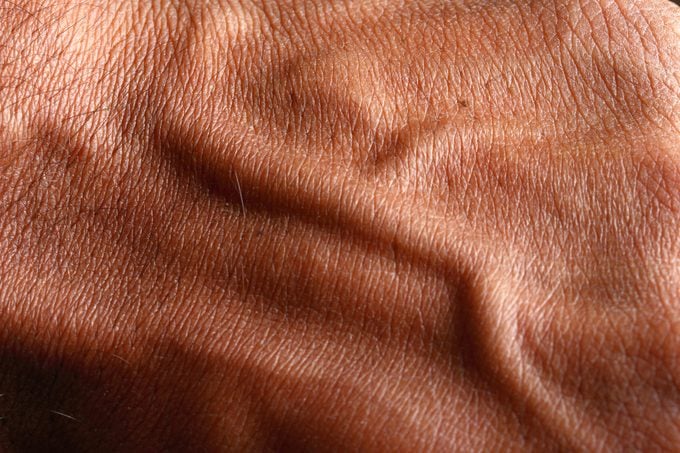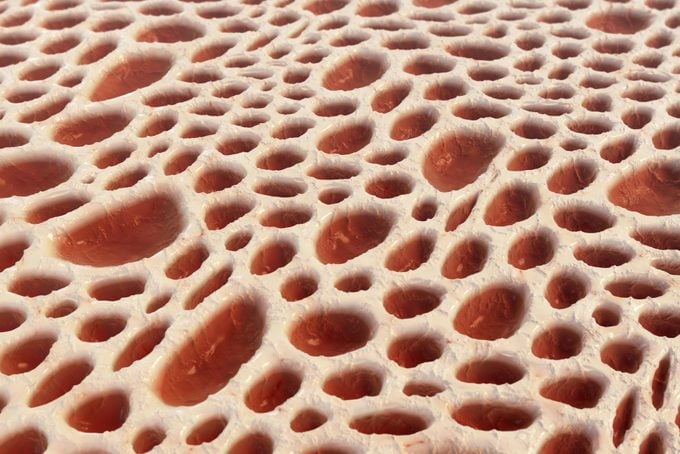10 Body Parts You Didn’t Know You Could (Legally) Sell
Updated: Feb. 28, 2024

People looking to pocket some extra cash might ask, "Can I sell my kidney?" These are the parts of your body you can profit from—legally.
Can I sell my kidney? It might be a gruesome question, but if you’re short on cash (or simply want to fund a splurge), you may just be willing to sell an arm and a leg. Thankfully, those aren’t legal to barter, exchange, trade or post for sale, but you can make a quick buck selling other body parts (and bodily functions). For instance, it’s illegal to sell blood, but it’s legal to sell blood plasma, a component of blood that’s in high demand.
If funds are low, we’ve got the lowdown on which body parts are legal (and illegal) to sell—and how much you can get for them. In some instances, the value of your donation is affected by inherited traits, such as having the rarest hair color. Others might be impacted by your health or gender. Some weird facts about the human body might affect your options as well. But be warned that the better the payday, the more intense or intrusive the process of giving likely is. Here’s what you need to know about profiting from your own body.
Get Reader’s Digest’s Read Up newsletter for trivia, humor, cleaning, travel, tech and fun facts all week long.
Can you sell your kidney?
No, organs are illegal to sell. While kidneys are in high demand (right now, almost 90,000 people are on the waiting list for donated kidneys, according to the Organ Procurement and Transplantation Network), the U.S. has strict laws regarding organ sales. Since 1984, the National Organ Transplant Act has made it illegal to sell organs, such as your kidneys, liver, heart, lungs or pancreas.
“There are many reasons these sales are illegal—one is that only the rich will be able to afford lifesaving treatments,” says Arthur Caplan, PhD, an advisor for the National Organ Transplant Act and head of the Division of Medical Ethics at New York University’s Grossman School of Medicine. “Another is that paying donors encourages them to lie about their health.”
Which body parts are legal to sell?
Body parts you can sell range from the easily accessible (like hair, breast milk, stool or sperm) to the difficult-to-retrieve (eggs). Some involve quick processes (donating blood plasma) while others are long-term commitments (being a surrogate). At least one calls for a high level of entrepreneurship. And many require disclosing medical and family history and even DNA, so be aware of who you’re supplying private information and delicate data to. So how much can I sell my kidney for? $0, as it turns out. But here’s how you can make a few bucks—if you’re willing.
Hair

How much it goes for: $100–$1,210
Hair that’s long and has not been altered by salon processes (also known as “virgin hair”) is the most sought after and fetches the highest price. What other type of hair goes for the big bucks? The rarest of them all: red hair. You can reach out to specific wigmakers or you can put your hair up for sale on websites, such as hairselloff.com, which offers a handy price calculator. Twenty-four inches of very thick red hair will net you $1,210. Local wig shops and eBay are other spots to promote your locks.
How in demand are human tresses? Whether someone’s masking hair damage, temporarily changing up styles or dealing with hair loss due to cancer treatments or diseases such as alopecia, wigs made of real human tresses instead of synthetic hair are a popular choice. (You can also donate at places like Wigs and Wishes if you’d like your hair to go directly to cancer patients.)
Stool
How much it goes for: $500
Yes, you read that right. Your bowel movements could get you paid—a lot. At the very top of the pay scale, stool donations to an organization called Human Microbes bring $500 a pop, which can add up to more than $100,000 a year if you’re making contributions often.
So what are they doing with your bodily functions? The company is looking to collect gut microbes to be used in research or procedures that battle deadly gut infections. The easiest way to collect these gut microbes is by harvesting stool (poop) and offering it for fecal microbiota transplants (FMT), in which recipients swallow capsules of stool samples that contain beneficial microbes. “FMT is a life-saving treatment for the deadly gut infection Clostridium difficile, and has shown promising results in clinical trials for many other conditions, such as irritable bowel syndrome, inflammatory bowel disease and other conditions,” says Michael Harrop, founder of Human Microbes. “A non-monetary benefit to donors is potentially curing innumerable people of chronic diseases.”
They are looking for people healthy enough to be high-quality stool donors (“fewer than 0.1% of people with healthy, unperturbed, disease-resistant microbiomes,” their website reads). According to Harrop, the ideal donors are “top young athletes.”
Sperm

How much it goes for: $100–$125
“There’s a big demand for sperm donors not just in the United States but also throughout the world,” says Andrea Darrington, senior director of the donor and fertility program at California Cryobank, one of the largest sperm banks in the country. One benefit to becoming a donor is a thorough, months-long medical screening mandated by federal, state and company-specific rules.
“We collect three generations of family medical history and do a physical exam, psychological screening, infectious disease testing and advanced genetic screening for over 300 conditions,” Darrington says. “The vast majority of our donors go on to have children of their own, so this is great medical information for their future families.”
Donors who contribute three times a week—the max allowed—can haul in $1,500 a month. There are also other rewards. “Almost all the donors come with some kind of personal aspect—for instance, they have friends with fertility issues—that encourages them to help others by donating sperm,” notes Darrington.
Womb
How much it goes for: $45,000–$55,000
Did you enjoy being pregnant? Would you be interested in assisting couples struggling with infertility? You might be a great candidate for surrogacy. These days, surrogacy almost always means gestational surrogacy, in which the surrogate is not genetically related to the child. For surrogate mothers, agencies use women who have already had a successful pregnancy and delivery. From start to finish, the process usually takes 16 to 18 months, according to Circle Surrogacy, one of the country’s largest agencies. After medical and psychological tests, the surrogate must get matched with an appropriate intended parent or parents (these new “families” often establish an intense bond). At surrogacy agency Reproductive Possibilities, surrogates make $45,000 to $55,000, which includes your base fee and benefits/expenses. For the right person, surrogacy can be very rewarding. It’s also an incredibly kind and courageous thing to do.
Plasma
How much it goes for: $30–$60-plus per donation
The quickest way to make cash, blood plasma donation has become an important side hustle for many Americans. Unlike selling sperm or eggs, selling plasma only requires a simple screening process that takes place during your first visit and lasts less than an hour. You can expect to spend 90 minutes giving your plasma donation. Some companies will incentivize donations with first-time bonuses or other cash offers, which means contributing twice a week for a month could net you more than $600. Plus, the heavier you are, the more you can get paid.
So what’s so lucrative about plasma? Plasma is the light amber component of blood that carries electrolytes, nutrients, hormones and proteins throughout your body. It is given to trauma, burn and electric shock sufferers, as well as some kinds of liver patients. Demand is almost unlimited because the U.S. is one of a handful of countries where selling plasma is legal—a part of American plasma goes abroad. It is easy to find a plasma donation site, and major companies include OctaPharma Plasma, CSL Plasma, Biolife Plasma and Grifols—these outlets typically pay bonuses to new donors. And while studies have shown that people who give plasma regularly do not experience any long-term side effects, it is important to keep yourself healthy and hydrated throughout the process.
Skin

How much it goes for: Varies
While you cannot technically sell your skin, there are more creative ways to make money with it. In this world of intense economic competition, companies are looking for effective advertising opportunities. And one of the most creative methods is renting space on human skin. A few years ago, Red Sun Cigarettes, now out of business, paid people $1,500 to get its logo tattooed on their bodies. According to the New York Times, Air New Zealand offered either a round-trip ticket to New Zealand or $777 in cash for customers to act as cranial billboards, branding their shaved heads with a temporary tattoo. If you want to get into the “skinvertizing” business, your best bet is to post a notice on eBay, Craigslist, Reddit or TikTok. Beware of websites that make you pay a fee before you can look at listings—and some of the companies themselves. Caution abounds here.
Your entire body
How much it goes for: $75–$4,500
Universities, medical institutions and pharmaceutical companies are always in need of test subjects for clinical trials, some of which offer money. Phase I trials, the earliest studies, are the first done on humans and are the riskiest of the four trial phases, which is why they pay the best. Phase I studies test a drug or procedure’s safety, side effects and proper dosage, and have the fewest requirements to join. At Velocity Clinical Trials, which partners with pharmaceutical and biotechnology companies to test new products, participants can make between $75 to $4,500 for an entire trial. Other trustworthy places to look for paying and non-paying studies include the National Institutes of Health’s clinical trial database and the Center for Information and Study on Clinical Research Participation.
Eggs
How much they go for: $8,000
Demand for egg donations is booming. Between 2000 and 2010, the number of pregnancies using donor eggs grew almost 70%, according to numbers published in JAMA—and the figures continue to climb. Donation sites exist in almost every state, and potential donors (generally healthy, non-smoking women aged 21 to 29 who have both ovaries) go through a strenuous screening process. Eligible women are matched with a recipient and undergo a three- to four-week cycle consisting of hormone injections followed by an egg retrieval. At the well-known Center for Human Reproduction, donors are paid $8,000 for one cycle of eggs. They’re allowed to make six donations, at least three months apart, in their lifetimes.
Bone marrow

How much it goes for: $600
Up until 2012, donating bone marrow for money was illegal in the United States. But a federal court decision opened the doors to selling bone marrow using a particular kind of extraction process. Marrow is a source of stem cells critical to improving the immune systems of people suffering from leukemia, lymphoma and other diseases. At Lonza Donor Programs in Rockville, Maryland, eligible people are 18 to 45 years old, in good health and not engaged in high-risk behaviors, according to the site. Compensation is $600 immediately after the visit. You can donate every three months, up to 12 times in your life.
Breast milk
How much it goes for: $1 per ounce
Many nursing women produce much more milk than they need for their infants. Much of the donated and for-sale milk in the U.S. ends up in hospitals, and given recent formula shortages, donated breast milk is needed. (In 2022, the Human Milk Banking Association of North America dispensed nearly 10 million ounces of donor milk.)
If you want to get money for your excess milk, there are three types of venues: established for-profit milk banks, such as Tiny Treasures Milk Bank, which processes breast milk specifically for premature babies; breast-milk classified ad spaces like Only the Breast, which focuses on person-to-person sales; and social media outlets like Facebook Marketplace and Craigslist, which often pay higher than the standard $1 or $1.10 an ounce, but can involve a risk.
Additional reporting by Taylor Markarian.
About the experts
- Arthur Caplan, PhD, is the founding head of the Division of Medical Ethics at New York University’s Grossman School of Medicine. He was an advisor for the National Organ Transplant Act of 1984 and helped create the National Marrow Donor Program. He has written more than 860 papers in peer-reviewed journals and has written or edited 35 books, most recently Getting to Good: Research Integrity in the Biomedical Sciences.
- Andrea Darrington is the senior director of the donor and fertility program at California Cryobank. She has been managing program operations for the past 14 years. She has an MBA from West Texas A&M.
- Michael Harrop is head of operations for HumanMicrobes.org, which he founded in 2020. Previously, he was head of North American operations for Microbioma.org, a fecal bank located in Spain.
Sources:
- Organ Procurement and Transplantation Network: “Data”
- Wigs and Wishes: “Donate Your Hair”
- The Guardian: “The poo panacea: inside the strange, surprising world of faecal transplants”
- California Cryobank: “Find Your Hidden Gem”
- Circle Surrogacy: “The Surrogate Process”
- Reproductive Possibilities: “How much does a surrogate make?”
- Creative Family Connections: “Surrogate Compensation”
- OctaPharma Plasma: “Plasma”
- U.S. News & World Report: “What to Know About Donating Plasma for Money”
- New York Times: “The Body as Billboard: Your Ad Here”
- Velocity Clinical Research: “Join a clinical trial at Velocity”
- ClinicalTrials.gov: “Learn about clinical studies from around the world”
- Center for Information and Study on Clinical Research Participation: “Search clinical trials”
- Center for Human Reproduction: “Egg donation”
- Proceedings of the National Academy of Sciences: “Molecular description of dioxygen bonding in hemoglobin”
- JAMA: “Trends and Outcomes for Donor Oocyte Cycles in the United States, 2000–2010”
- Lonza Donor Programs: “Donate bone marrow”
- Tiny Treasures Milk Bank: “Donate breast milk”
- Only the Breast: “A community for moms to buy, sell and donate breast milk”
- National Conference of State Legislatures: “Donor Human Milk: More Valuable than Gold?”


